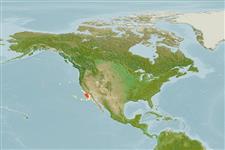>
Saccopharyngiformes (Swallowers and gulpers) >
Monognathidae (Onejaws)
Etymology: Monognathus: Greek, monos = one + Greek, gnathos = jaw (Ref. 45335).
Eponymy: Dr Elbert Halvor Ahlstrom (1910–1979) was an ichthyologist and biologist who spent more than four decades working for the National Fisheries Service. [...] (Ref. 128868), visit book page.
Environment: milieu / climate zone / depth range / distribution range
Écologie
marin benthopélagique; profondeur 0 - 2000 m (Ref. 58018). Temperate
Eastern Central Pacific: California, USA.
Taille / Poids / Âge
Maturity: Lm ? range ? - ? cm
Max length : 4.9 cm TL mâle / non sexé; (Ref. 34506)
Mesopelagic (Ref. 96339).
Life cycle and mating behavior
Maturité | Reproduction | Frai | Œufs | Fécondité | Larves
Hubbs, C.L., W.I. Follett and L.J. Dempster, 1979. List of the fishes of California. Occasional Papers of the California Academy of Sciences, San Francisco, California, USA, No. 133, 51 p. (Ref. 7182)
Statut dans la liste rouge de l'IUCN (Ref. 130435: Version 2024-1)
Menace pour l'homme
Harmless
Utilisations par l'homme
Outils
Articles particuliers
Télécharger en XML
Sources Internet
Estimates based on models
Preferred temperature (Ref.
123201): 4.5 - 7.7, mean 5.4 °C (based on 16 cells).
Phylogenetic diversity index (Ref.
82804): PD
50 = 0.5001 [Uniqueness, from 0.5 = low to 2.0 = high].
Bayesian length-weight: a=0.00102 (0.00046 - 0.00225), b=3.06 (2.88 - 3.24), in cm total length, based on all LWR estimates for this body shape (Ref.
93245).
Niveau trophique (Ref.
69278): 3.2 ±0.5 se; based on size and trophs of closest relatives
Fishing Vulnerability (Ref.
59153): Low vulnerability (10 of 100).
